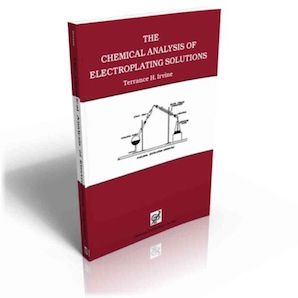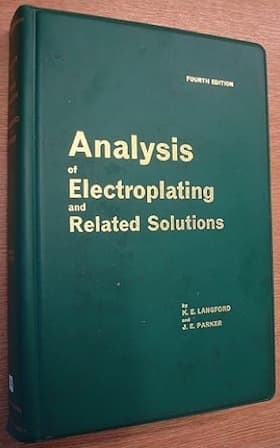
Curated with aloha by
Ted Mooney, P.E. RET

The authoritative public forum
for Metal Finishing 1989-2025

-----
Looking for a titration method for ferric chloride
Q. I use FeCl3 solution to etch steel and a second batch of solution to etch copper. I want to analyse for free Fe and Cu respectively to decide the life of the solution. When to refresh? What is most economic method to analyse solution of FeCl3? I maintain Baumé but the presence of Fe can misguide Baumé
Kaushik Magiawala- Chhatral Gandhinagar
April 19, 2021
A. Hi Kaushik. While awaiting responses, you may wish to read the earlier entries on this thread. You may also find Barlow Campano's article "Kleingarn Regenerated Spent Acid at Increasing Ferrous & ferric chloride Content" in our on-line reference library interesting.
Luck & Regards,

Ted Mooney, P.E. RET
Striving to live Aloha
finishing.com - Pine Beach, New Jersey
⇩ Related postings, oldest first ⇩
Q. My ferric chloride
⇦ this on
eBay or
Amazon [affil links] etching solution consists of the following proportions:
290 grams- ferric chloride
⇦ this on
eBay or
Amazon [affil links] (technical grade Fe c13-6H2O)
290 milliliters- hydrochloric acid (HCl muriatic 35.6% specific gravity 1.18)
570 milliliters- water
I work in the aerospace industry and am currently changing my ferric chloride
⇦ this on
eBay or
Amazon [affil links] solution when it fails to etch my parts to a Kodak paper gray scale within a specified amount of time. I am looking for a simple method of testing the concentration of ferric chloride
⇦ this on
eBay or
Amazon [affil links] within this bath. Testing the acid concentration will not help because I use this solution to etch stainless steel. I have a titration method for two acid baths (nitric and muriatic diluted with alcohol)using 0.5N NaOH
⇦ this on
eBay
or
Amazon [affil links]
and phenolphthalein
⇦ this on
eBay &
Amazon [affil links]
and titrating to a pink endpoint.
I would appreciate any help for finding a simple titration method.
Thank You,
manufacturing - Falconer, New York
2006
by Terrance H Irvine

on eBay or
AbeBooks
or Amazon
(affil links)
by Langford & Parker

on Abebooks
or Amazon
(UTL on eBay)
(affil links)
A. phenolphthalein is not a good indicator for your acid titration because of the high pH of 9 (plus or minus). At an alkaline pH, you are getting a false reading as metals start to precipitate out as hydroxides, using part of your titrant. I think that you can see the endpoint of methyl red ⇦ this on eBay & Amazon [affil links] , pH of about 5. methyl orange ⇦ this on eBay or Amazon [affil links] would probably be tough to see in a ferric chloride ⇦ this on eBay or Amazon [affil links] solution.
James Watts- Navarre, Florida
A. Hmmm. It's a tough problem because the acidity doesn't change, just the solution metal loading.
You could try this: take a suitably sized sample (trial and error testing would be necessary to determine this) and dilute it up to 100 ml with water, then add aq. NH3 to pH 11 or so. Filter out precipitated metal hydroxides to get a solution that should only contain the nickel. I'm assuming you're processing a stainless steel with nickel in it - most do.
Now, add some murexide
[affil links] indicator, and titrate with 0.1 M EDTA to a violet endpoint. This, after a simple arithmetical calculation, will give you the nickel loading, which should be correlatable to your etch test.
Or, wait a few days. Someone who actually does this type of work themselves may have a method all worked out. In that case, you should listen to them.

Dave Wichern
Consultant - The Bronx, New York
A. I'm not going to look up the fudge factors, etc., but if you do an acid/base titration for HCl and a total chloride titration (titrate w/AgNO3, chromate indicator), you could then subtract out the chloride from HCl. What's left comes from the ferric chloride
⇦ this on
eBay or
Amazon [affil links] .
Were I in your shoes, though, I'd just use an ORP controller.

James Totter, CEF
- Tallahassee, Florida
Q. Blake,
I don't have a response to your question, but I am interested in the FeCl3 etch solution you reference. I have some stainless steel parts that require temper etch inspection, and an etch solution very similar to the one you reference has been suggested. I would like to discuss this process.
propeller systems - Columbus, Georgia, USA
January 5, 2011
A. Reduce your ferric chloride
⇦ this on
eBay or
Amazon [affil links] (Fe3+) down to ferrous chloride (Fe2+) using tin chloride (SnCl2). Keep adding the tin chloride until the solution turns clear. Then precipitate out the excess tin chloride with mercury chloride (HgCl). Be careful because mercury can be toxic. Add the mercury chloride to the solution until it doesn't dissolve anymore. Let this solution settle out until you have a clear liquid on top, and precipitate at the bottom.
For the titration, siphon off a known quantity of the clear liquid and titrate with potassium permanganate
⇦ this on
eBay or
Amazon [affil links] (KMnO4). Measure the ORP as you titrate - you should start out around 400-500 with Fe2+, and add KMnO4 until you hit 900 mV or so (Fe3+). Use the quantity of KMnO4 it took to hit 900 mV ORP as your titration quantity, and multiply the # moles of this additive by 5 to figure out how many moles of iron was in your original solution
- Boston, Massachusetts
June 13, 2013
Readers may also be interested in these related threads:
• Topic #106/43 "Analyze acid level (HCl) in ferric chloride solution"
• Topic #256/87 "Looking for a titration method for ferric chloride"
Q, A, or Comment on THIS thread -or- Start a NEW Thread